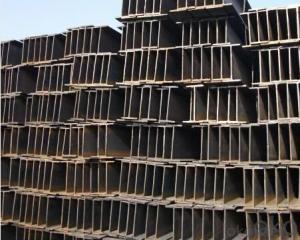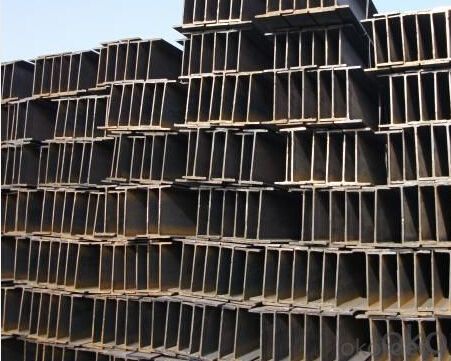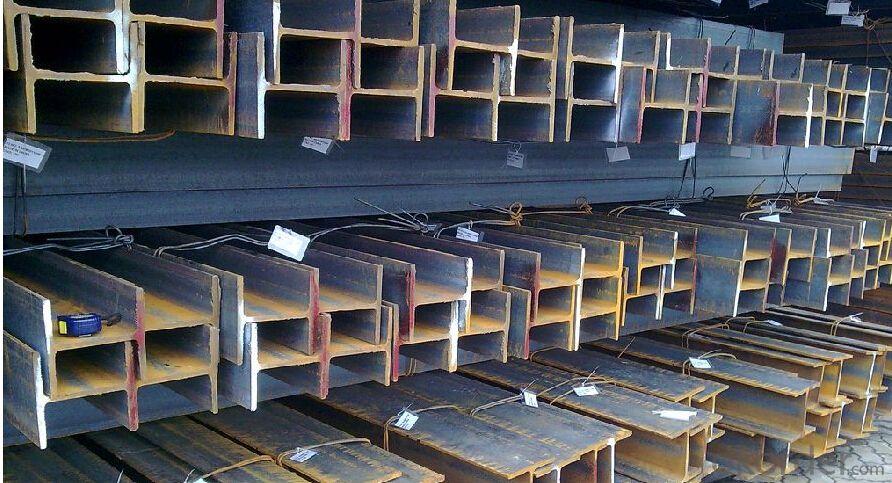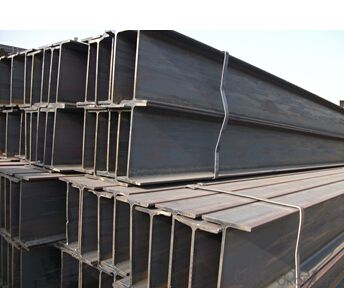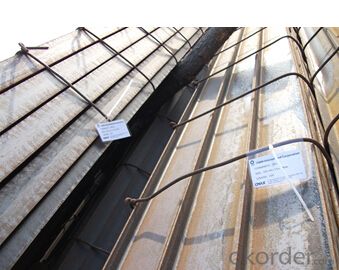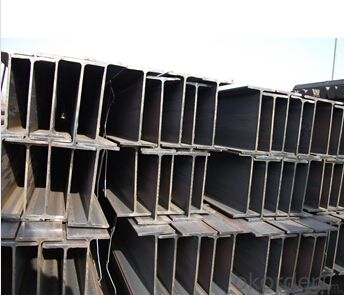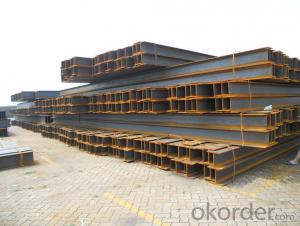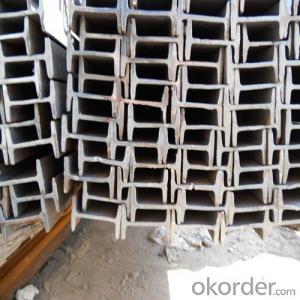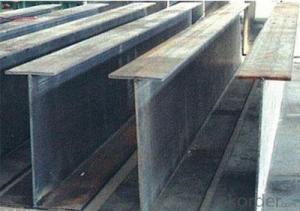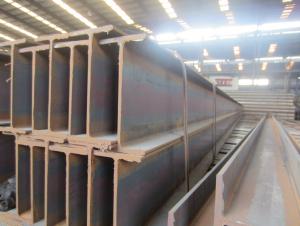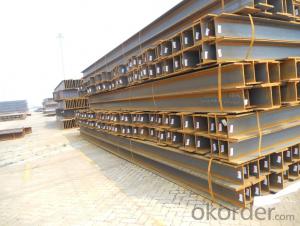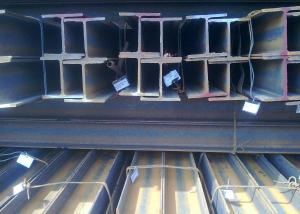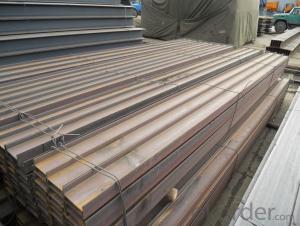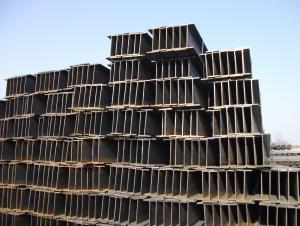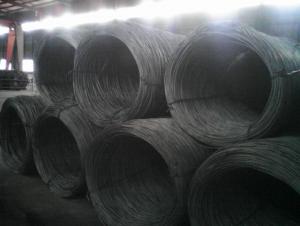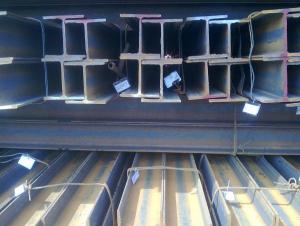Hot Rolled High Prime Structural Steel H Beam
- Loading Port:
- China Main Port
- Payment Terms:
- TT or LC
- Min Order Qty:
- -
- Supply Capability:
- -
OKorder Service Pledge
OKorder Financial Service
You Might Also Like
Product Description:
OKorder is offering Hot Rolled High Prime Structural Steel H Beam at great prices with worldwide shipping. Our supplier is a world-class manufacturer of steel, with our products utilized the world over. OKorder annually supplies products to European, North American and Asian markets. We provide quotations within 24 hours of receiving an inquiry and guarantee competitive prices.
Product Applications:
Hot Rolled High Prime Structural Steel H Beam are ideal for structural applications and are widely used in the construction of buildings and bridges, and the manufacturing, petrochemical, and transportation industries.
Product Advantages:
OKorder's Hot Rolled High Prime Structural Steel H Beam are durable, strong, and resist corrosion.
Main Product Features:
· Premium quality
· Prompt delivery & seaworthy packing (30 days after receiving deposit)
· Corrosion resistance
· Can be recycled and reused
· Mill test certification
· Professional Service
· Competitive pricing
Specifications of Hot Rolled high prime Structural Steel H Beam
1. Standard: GB700-88, Q235B2.
2. Grade: Q235, SS400 or Equivalent
3. Length: 6m,10m, 12m as following table
4. Invoicing on theoretical weight or actual weight as customer request
5.Payment: TT or L/C
6. Sizes:
SIZE(mm) | DIMENSION(kg/m) |
100*100 | 16.9 |
125*125 | 23.6 |
150*75 | 14 |
150*150 | 31.1 |
148*100 | 20.7 |
198*99 | 17.8 |
200*100 | 20.9 |
248*124 | 25.1 |
250*125 | 29 |
Usage & Applications of Hot Rolled High Prime Structural Steel H Beam
Commercial building structure ;Pre-engineered buildings; Machinery support structure; Prefabricated structure; Medium scale bridges; Ship-building structure. etc.
Packaging & Delivery of Hot Rolled Structural Steel H Beam
1. Packing: it is nude packed in bundles by steel wire rod
2. Bundle weight: not more than 3.5MT for bulk vessel; less than 3 MT for container load
3. Marks:
Color marking: There will be color marking on both end of the bundle for the cargo delivered by bulk vessel. That makes it easily to distinguish at the destination port.
Tag mark: there will be tag mark tied up on the bundles. The information usually including supplier logo and name, product name, made in China, shipping marks and other information request by the customer.
If loading by container the marking is not needed, but we will prepare it as customer request.
4. Transportation: the goods are delivered by truck from mill to loading port, the maximum quantity can be loaded is around 40MTs by each truck. If the order quantity cannot reach the full truck loaded, the transportation cost per ton will be little higher than full load.
5. Delivered by container or bulk vessel
Production flow of Hot Rolled Structural Steel H Beam
Material prepare (billet) —heat up—rough rolling—precision rolling—cooling—packing—storage and transportation
FAQ:
Q1: Why buy Materials & Equipment from OKorder.com?
A1: All products offered byOKorder.com are carefully selected from China's most reliable manufacturing enterprises. Through its ISO certifications, OKorder.com adheres to the highest standards and a commitment to supply chain safety and customer satisfaction.
Q2: How do we guarantee the quality of our products?
A2: We have established an advanced quality management system which conducts strict quality tests at every step, from raw materials to the final product. At the same time, we provide extensive follow-up service assurances as required.
Q3: How soon can we receive the product after purchase?
A3: Within three days of placing an order, we will begin production. The specific shipping date is dependent upon international and government factors, but is typically 7 to 10 workdays.

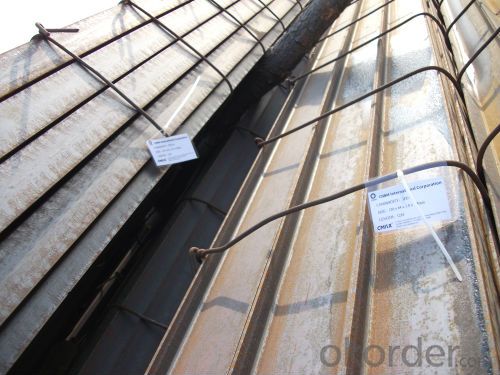
- Q: Are steel H-beams resistant to pests and insects?
- Yes, steel H-beams are highly resistant to pests and insects as they do not provide a suitable environment for them to inhabit or cause damage.
- Q: What are the different types of connections used for steel H-beams in bridges?
- There are several different types of connections used for steel H-beams in bridges, including bolted connections, welded connections, and hybrid connections. Bolted connections involve using bolts to connect the H-beams together, providing a strong and easily disassembled connection. Welded connections involve fusing the H-beams together using heat and filler material, creating a permanent and durable connection. Hybrid connections combine elements of both bolted and welded connections, utilizing bolts in certain areas and welding in others to achieve a balance between strength and ease of assembly. The choice of connection type depends on factors such as the design requirements, load capacity, and construction process.
- Q: Can steel H-beams be used in the construction of railway infrastructure?
- Yes, steel H-beams can be used in the construction of railway infrastructure. These beams are commonly used as a structural element in various construction projects, including bridges, buildings, and railways. They offer high strength and durability, making them suitable for supporting heavy loads and withstanding the dynamic forces associated with railway operations.
- Q: What are the different fabrication methods for steel H-beams?
- Steel H-beams can be manufactured using several fabrication methods, such as hot rolling, cold rolling, and welding. The most commonly used method for fabricating steel H-beams is hot rolling. This involves heating a steel billet to a high temperature and then passing it through rolling stands to shape it into the desired H-beam profile. The elevated temperature makes the steel more malleable, allowing for easy formation into the H-shape. This technique produces high-quality H-beams with exceptional structural integrity. Another fabrication method is cold rolling, where the steel is passed through rolling stands at room temperature. This process enhances the surface finish and dimensional accuracy of the H-beams. Cold rolling is typically employed for producing smaller and lighter H-beams, which are often used in applications where weight and size are crucial factors. Welding is also utilized in the fabrication of steel H-beams. This method involves joining individual steel plates or sections together to create the H-beam shape. Welding offers greater flexibility in terms of size and shape, making it suitable for custom or non-standard applications. However, it should be noted that welded H-beams may have slightly lower structural integrity compared to those produced through hot or cold rolling. The choice of fabrication method for steel H-beams depends on various factors, including size, shape, and application requirements. Each method has its own advantages and limitations, and manufacturers carefully select the most suitable approach based on the specific project needs.
- Q: Are steel H-beams recyclable?
- Yes, steel H-beams are recyclable. Steel is one of the most commonly recycled materials in the world, and H-beams are no exception. When steel H-beams reach the end of their useful life or are no longer needed, they can be collected, processed, and then melted down to create new steel products. The recycling process involves shredding the H-beams into smaller pieces, removing any impurities, and then melting the steel in a furnace. Once melted, the steel can be used to produce a wide range of new products, including new H-beams. Recycling steel H-beams not only helps to conserve natural resources but also reduces the environmental impact associated with mining and manufacturing new steel.
- Q: What are the different types of connections used for steel H-beams to masonry?
- Masonry commonly utilizes several types of connections for steel H-beams. These connections are intended to establish a secure and stable bond between the steel beam and the masonry structure. One prevalent connection type is the welded connection. This method involves directly welding the steel beam to the masonry using high-strength welding techniques. Welded connections offer exceptional strength and rigidity, making them a favored option for heavy-duty applications. Another connection type is the bolted connection. This entails using bolts and nuts to secure the steel beam to the masonry. Bolted connections allow for easy disassembly and reassembly, making them suitable for situations where the steel beam may require removal or replacement in the future. An alternative to traditional welding or bolting is the utilization of mechanical connectors. These connectors, also known as steel plates or brackets, are designed to establish a robust connection between the steel beam and the masonry. They are typically attached to the beam using bolts or welds and then embedded in the masonry during construction. Furthermore, adhesive connections can be employed to bond the steel beam to the masonry. This involves applying a high-strength adhesive material between the beam and the masonry surface. Adhesive connections provide a clean and aesthetically pleasing appearance as they remain hidden from view. The choice of connection type depends on various factors such as load-bearing requirements, structural design, construction method, and project specifications. It is crucial to seek advice from a structural engineer or a professional well-versed in steel-to-masonry connections to determine the most suitable connection method for a specific project.
- Q: Are steel H-beams suitable for structures with dynamic loads?
- Yes, steel H-beams are suitable for structures with dynamic loads. H-beams, also known as I-beams, are commonly used in construction due to their high strength-to-weight ratio, which makes them ideal for supporting heavy loads. The shape of an H-beam provides excellent resistance to bending, making it well-suited for structures that experience dynamic loads, such as bridges, cranes, and high-rise buildings. Steel H-beams possess superior structural integrity and can withstand the forces generated by dynamic loads, including vibrations, impacts, and cyclic loading. They are designed to distribute the load evenly along their length, minimizing stress concentrations and preventing deformation or failure. Moreover, steel is a durable material that exhibits excellent fatigue resistance, allowing H-beams to withstand repeated loading and unloading without compromising their mechanical properties. This makes them highly suitable for structures that experience varying or dynamic loads over time. Additionally, steel H-beams can be customized to meet specific structural requirements, such as length, size, and strength, making them versatile for a wide range of applications. They can be fabricated and connected to form complex structural systems that can efficiently handle dynamic loads. Overall, steel H-beams are a reliable and widely used choice in structural engineering for buildings and infrastructure that are subjected to dynamic loads.
- Q: What are the different design codes and standards applicable to steel H-beams?
- There are several design codes and standards applicable to steel H-beams, which ensure their structural integrity and safe usage in various applications. Some of the prominent design codes and standards include: 1. American Institute of Steel Construction (AISC): AISC provides design guidelines and specifications for steel structures, including H-beams. The AISC Manual of Steel Construction is widely used in the United States and provides comprehensive information on the design, fabrication, and erection of steel structures. 2. European Norms (EN): The European Norms, specifically EN 1993-1-1 (Eurocode 3), provide design rules for steel structures in Europe. These norms include provisions for the design of H-beams and their connections, taking into account factors such as material properties, loadings, and stability requirements. 3. British Standards (BS): British Standards, such as BS 5950-1 and BS EN 1993-1-1, provide design recommendations for steel structures in the United Kingdom. These standards cover the design of H-beams, including factors like member capacities, buckling resistance, and connection design. 4. Canadian Standards Association (CSA): CSA S16, the Canadian standard for the design of steel structures, includes provisions for the design and analysis of H-beams. This standard covers topics like member design, stability considerations, and seismic design requirements. 5. Australian Standards (AS): The Australian Standards, particularly AS 4100, provide guidelines for the design and construction of steel structures in Australia. These standards cover the design of H-beams, including aspects like loadings, material properties, and construction details. 6. International Organization for Standardization (ISO): ISO 14346 is an international standard that specifies the requirements for hot-rolled H-beams with narrow flanges and wide flanges. It provides dimensional and structural specifications for H-beams manufactured globally. These design codes and standards serve as crucial references for engineers and designers involved in the design and construction of steel H-beams. By following these guidelines, they can ensure the structural safety, integrity, and compliance of H-beams with industry-accepted practices and regulations.
- Q: Can steel H-beams be used in agricultural buildings?
- Indeed, agricultural buildings can make use of steel H-beams. These H-beams, known for their robustness and endurance, are frequently employed in construction. They offer the essential structural reinforcement and stability that agricultural buildings demand. Moreover, steel H-beams possess resistance against pests, decay, and fire, rendering them fitting for agricultural settings. Their adaptability permits a wide range of design possibilities, accommodating diverse sizes and arrangements of agricultural buildings. In essence, steel H-beams present a dependable and effective option for the construction of agricultural buildings.
- Q: What are the characteristics of steel H-beams that make them suitable for industrial applications?
- Steel H-beams have several characteristics that make them ideal for industrial applications. Firstly, they have a high strength-to-weight ratio, which enables them to bear heavy loads while minimizing their own weight. This makes them suitable for constructing large structures such as bridges, buildings, and industrial facilities. Additionally, their durability and resistance to deformation and bending ensure structural stability and longevity. Moreover, the H shape provides enhanced support and stability, allowing for efficient distribution of weight and reducing the need for additional support structures. These characteristics make steel H-beams a reliable and cost-effective choice for various industrial applications.
Send your message to us
Hot Rolled High Prime Structural Steel H Beam
- Loading Port:
- China Main Port
- Payment Terms:
- TT or LC
- Min Order Qty:
- -
- Supply Capability:
- -
OKorder Service Pledge
OKorder Financial Service
Similar products
Hot products
Hot Searches
Related keywords
